Business Maths Portfolio: Module on Business Mathematics, 2024
VerifiedAdded on 2020/06/06
|25
|5323
|145
Homework Assignment
AI Summary
This Business Maths Portfolio assesses the application of numerical skills, concepts, and techniques within business and academic contexts. It is divided into four sections, with the first three sections assessed on a pass/fail basis, focusing on skills audits, in-class activities, and online activities related to topics like order of operations (BODMAS), operations on positive and negative numbers, fractions, ratios, decimals, percentages, and index numbers. Section 4 comprises ten questions that contribute significantly to the final mark, requiring students to demonstrate their understanding and ability to solve problems related to the covered topics. The portfolio includes reflections on personal learning experiences, real-life problem-solving scenarios, and evidence of completing online activities.
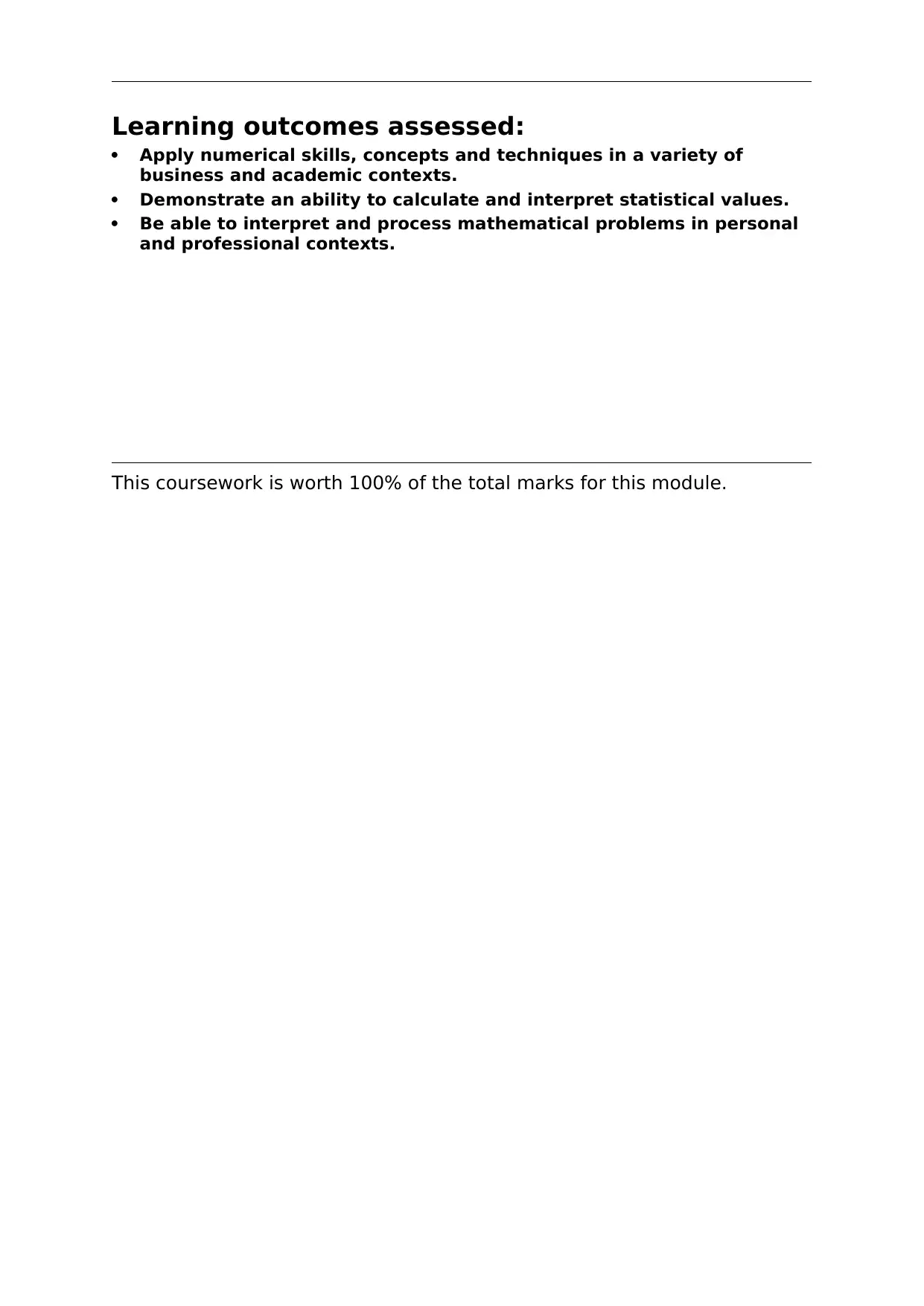
Learning outcomes assessed:
Apply numerical skills, concepts and techniques in a variety of
business and academic contexts.
Demonstrate an ability to calculate and interpret statistical values.
Be able to interpret and process mathematical problems in personal
and professional contexts.
This coursework is worth 100% of the total marks for this module.
Apply numerical skills, concepts and techniques in a variety of
business and academic contexts.
Demonstrate an ability to calculate and interpret statistical values.
Be able to interpret and process mathematical problems in personal
and professional contexts.
This coursework is worth 100% of the total marks for this module.
Paraphrase This Document
Need a fresh take? Get an instant paraphrase of this document with our AI Paraphraser
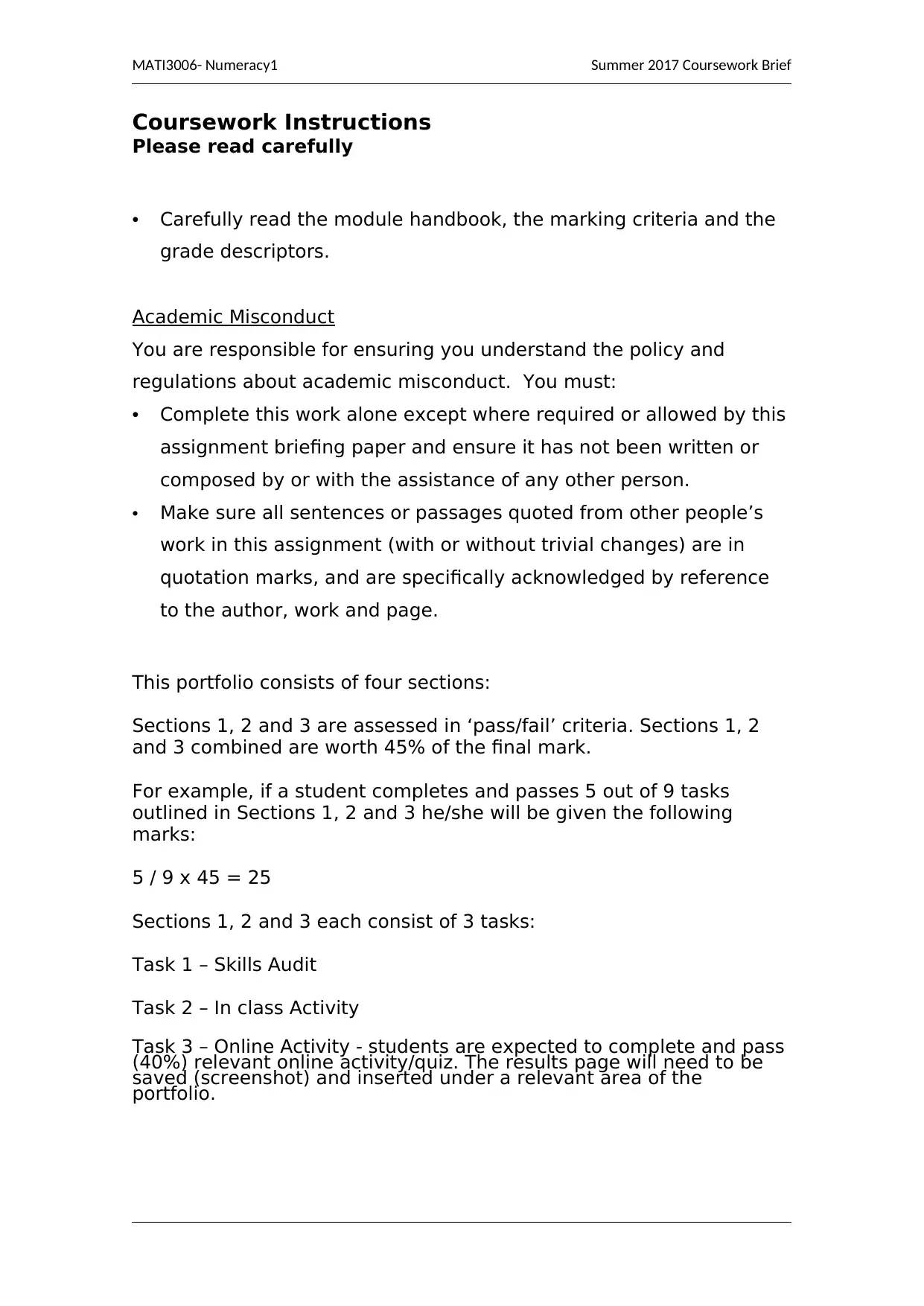
MATI3006- Numeracy1 Summer 2017 Coursework Brief
Coursework Instructions
Please read carefully
• Carefully read the module handbook, the marking criteria and the
grade descriptors.
Academic Misconduct
You are responsible for ensuring you understand the policy and
regulations about academic misconduct. You must:
• Complete this work alone except where required or allowed by this
assignment briefing paper and ensure it has not been written or
composed by or with the assistance of any other person.
• Make sure all sentences or passages quoted from other people’s
work in this assignment (with or without trivial changes) are in
quotation marks, and are specifically acknowledged by reference
to the author, work and page.
This portfolio consists of four sections:
Sections 1, 2 and 3 are assessed in ‘pass/fail’ criteria. Sections 1, 2
and 3 combined are worth 45% of the final mark.
For example, if a student completes and passes 5 out of 9 tasks
outlined in Sections 1, 2 and 3 he/she will be given the following
marks:
5 / 9 x 45 = 25
Sections 1, 2 and 3 each consist of 3 tasks:
Task 1 – Skills Audit
Task 2 – In class Activity
Task 3 – Online Activity - students are expected to complete and pass
(40%) relevant online activity/quiz. The results page will need to be
saved (screenshot) and inserted under a relevant area of the
portfolio.
Coursework Instructions
Please read carefully
• Carefully read the module handbook, the marking criteria and the
grade descriptors.
Academic Misconduct
You are responsible for ensuring you understand the policy and
regulations about academic misconduct. You must:
• Complete this work alone except where required or allowed by this
assignment briefing paper and ensure it has not been written or
composed by or with the assistance of any other person.
• Make sure all sentences or passages quoted from other people’s
work in this assignment (with or without trivial changes) are in
quotation marks, and are specifically acknowledged by reference
to the author, work and page.
This portfolio consists of four sections:
Sections 1, 2 and 3 are assessed in ‘pass/fail’ criteria. Sections 1, 2
and 3 combined are worth 45% of the final mark.
For example, if a student completes and passes 5 out of 9 tasks
outlined in Sections 1, 2 and 3 he/she will be given the following
marks:
5 / 9 x 45 = 25
Sections 1, 2 and 3 each consist of 3 tasks:
Task 1 – Skills Audit
Task 2 – In class Activity
Task 3 – Online Activity - students are expected to complete and pass
(40%) relevant online activity/quiz. The results page will need to be
saved (screenshot) and inserted under a relevant area of the
portfolio.
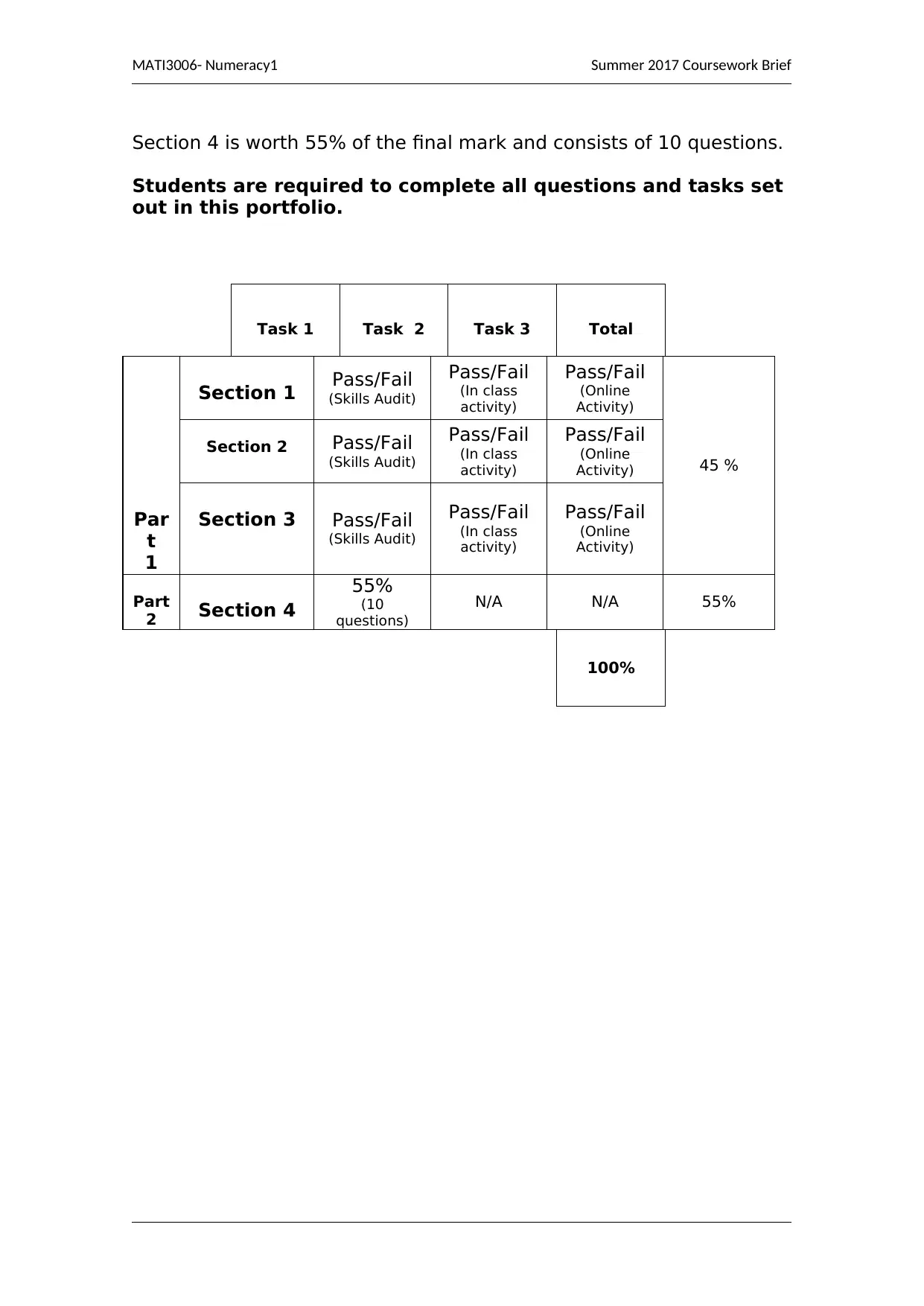
MATI3006- Numeracy1 Summer 2017 Coursework Brief
Section 4 is worth 55% of the final mark and consists of 10 questions.
Students are required to complete all questions and tasks set
out in this portfolio.
Task 1 Task 2 Task 3 Total
Par
t
1
Section 1 Pass/Fail
(Skills Audit)
Pass/Fail
(In class
activity)
Pass/Fail
(Online
Activity)
45 %
Section 2 Pass/Fail
(Skills Audit)
Pass/Fail
(In class
activity)
Pass/Fail
(Online
Activity)
Section 3 Pass/Fail
(Skills Audit)
Pass/Fail
(In class
activity)
Pass/Fail
(Online
Activity)
Part
2 Section 4
55%
(10
questions)
N/A N/A 55%
100%
Section 4 is worth 55% of the final mark and consists of 10 questions.
Students are required to complete all questions and tasks set
out in this portfolio.
Task 1 Task 2 Task 3 Total
Par
t
1
Section 1 Pass/Fail
(Skills Audit)
Pass/Fail
(In class
activity)
Pass/Fail
(Online
Activity)
45 %
Section 2 Pass/Fail
(Skills Audit)
Pass/Fail
(In class
activity)
Pass/Fail
(Online
Activity)
Section 3 Pass/Fail
(Skills Audit)
Pass/Fail
(In class
activity)
Pass/Fail
(Online
Activity)
Part
2 Section 4
55%
(10
questions)
N/A N/A 55%
100%
⊘ This is a preview!⊘
Do you want full access?
Subscribe today to unlock all pages.

Trusted by 1+ million students worldwide

MATI3006- Numeracy1 Summer 2017 Coursework Brief
Paraphrase This Document
Need a fresh take? Get an instant paraphrase of this document with our AI Paraphraser

MATI3006- Numeracy1 Summer 2017 Coursework Brief
Blank
Blank
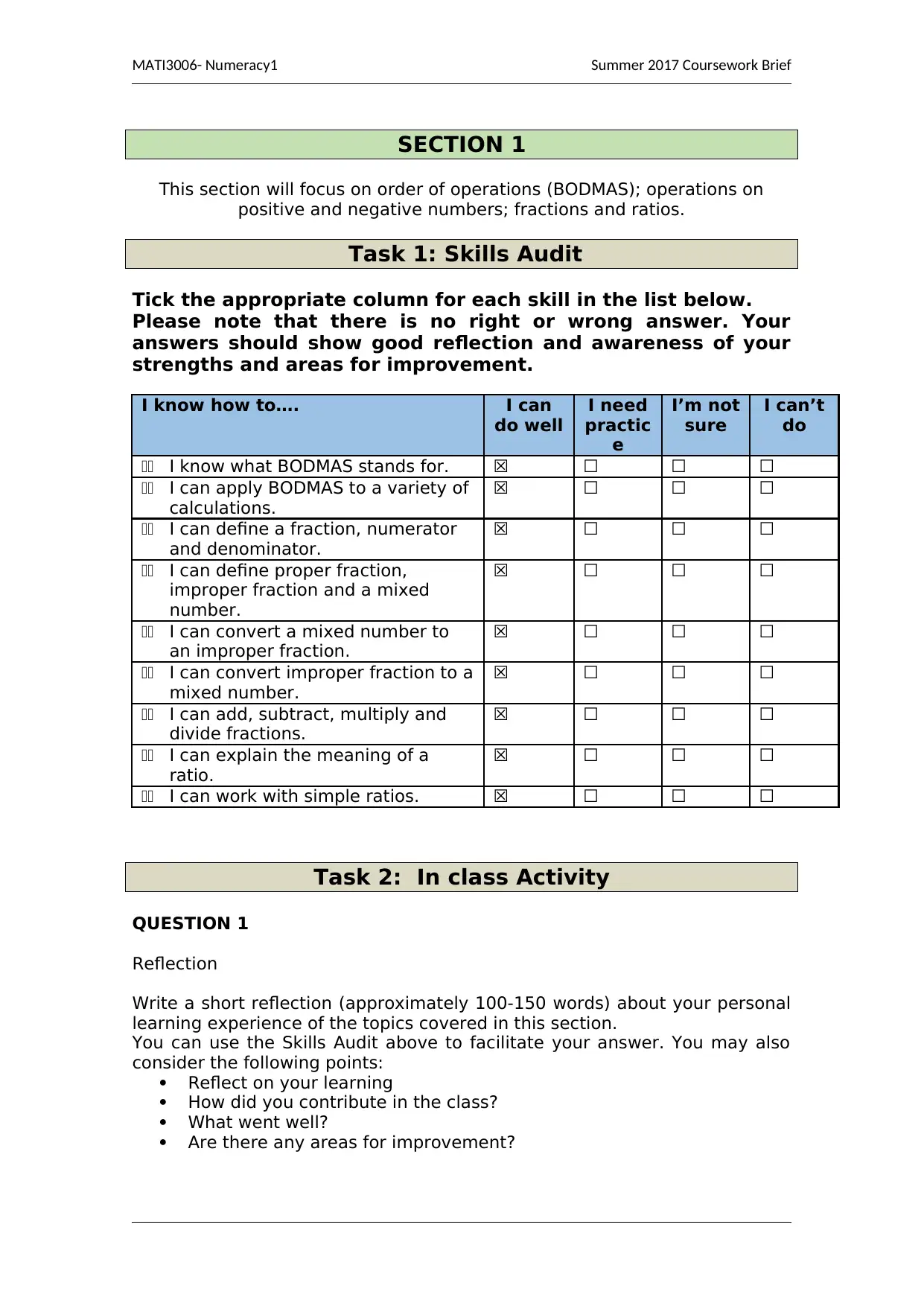
MATI3006- Numeracy1 Summer 2017 Coursework Brief
SECTION 1
This section will focus on order of operations (BODMAS); operations on
positive and negative numbers; fractions and ratios.
Task 1: Skills Audit
Tick the appropriate column for each skill in the list below.
Please note that there is no right or wrong answer. Your
answers should show good reflection and awareness of your
strengths and areas for improvement.
I know how to…. I can
do well
I need
practic
e
I’m not
sure
I can’t
do
11 I know what BODMAS stands for. ☒ ☐ ☐ ☐
11 I can apply BODMAS to a variety of
calculations.
☒ ☐ ☐ ☐
11 I can define a fraction, numerator
and denominator.
☒ ☐ ☐ ☐
11 I can define proper fraction,
improper fraction and a mixed
number.
☒ ☐ ☐ ☐
11 I can convert a mixed number to
an improper fraction.
☒ ☐ ☐ ☐
11 I can convert improper fraction to a
mixed number.
☒ ☐ ☐ ☐
11 I can add, subtract, multiply and
divide fractions.
☒ ☐ ☐ ☐
11 I can explain the meaning of a
ratio.
☒ ☐ ☐ ☐
11 I can work with simple ratios. ☒ ☐ ☐ ☐
Task 2: In class Activity
QUESTION 1
Reflection
Write a short reflection (approximately 100-150 words) about your personal
learning experience of the topics covered in this section.
You can use the Skills Audit above to facilitate your answer. You may also
consider the following points:
Reflect on your learning
How did you contribute in the class?
What went well?
Are there any areas for improvement?
SECTION 1
This section will focus on order of operations (BODMAS); operations on
positive and negative numbers; fractions and ratios.
Task 1: Skills Audit
Tick the appropriate column for each skill in the list below.
Please note that there is no right or wrong answer. Your
answers should show good reflection and awareness of your
strengths and areas for improvement.
I know how to…. I can
do well
I need
practic
e
I’m not
sure
I can’t
do
11 I know what BODMAS stands for. ☒ ☐ ☐ ☐
11 I can apply BODMAS to a variety of
calculations.
☒ ☐ ☐ ☐
11 I can define a fraction, numerator
and denominator.
☒ ☐ ☐ ☐
11 I can define proper fraction,
improper fraction and a mixed
number.
☒ ☐ ☐ ☐
11 I can convert a mixed number to
an improper fraction.
☒ ☐ ☐ ☐
11 I can convert improper fraction to a
mixed number.
☒ ☐ ☐ ☐
11 I can add, subtract, multiply and
divide fractions.
☒ ☐ ☐ ☐
11 I can explain the meaning of a
ratio.
☒ ☐ ☐ ☐
11 I can work with simple ratios. ☒ ☐ ☐ ☐
Task 2: In class Activity
QUESTION 1
Reflection
Write a short reflection (approximately 100-150 words) about your personal
learning experience of the topics covered in this section.
You can use the Skills Audit above to facilitate your answer. You may also
consider the following points:
Reflect on your learning
How did you contribute in the class?
What went well?
Are there any areas for improvement?
⊘ This is a preview!⊘
Do you want full access?
Subscribe today to unlock all pages.

Trusted by 1+ million students worldwide
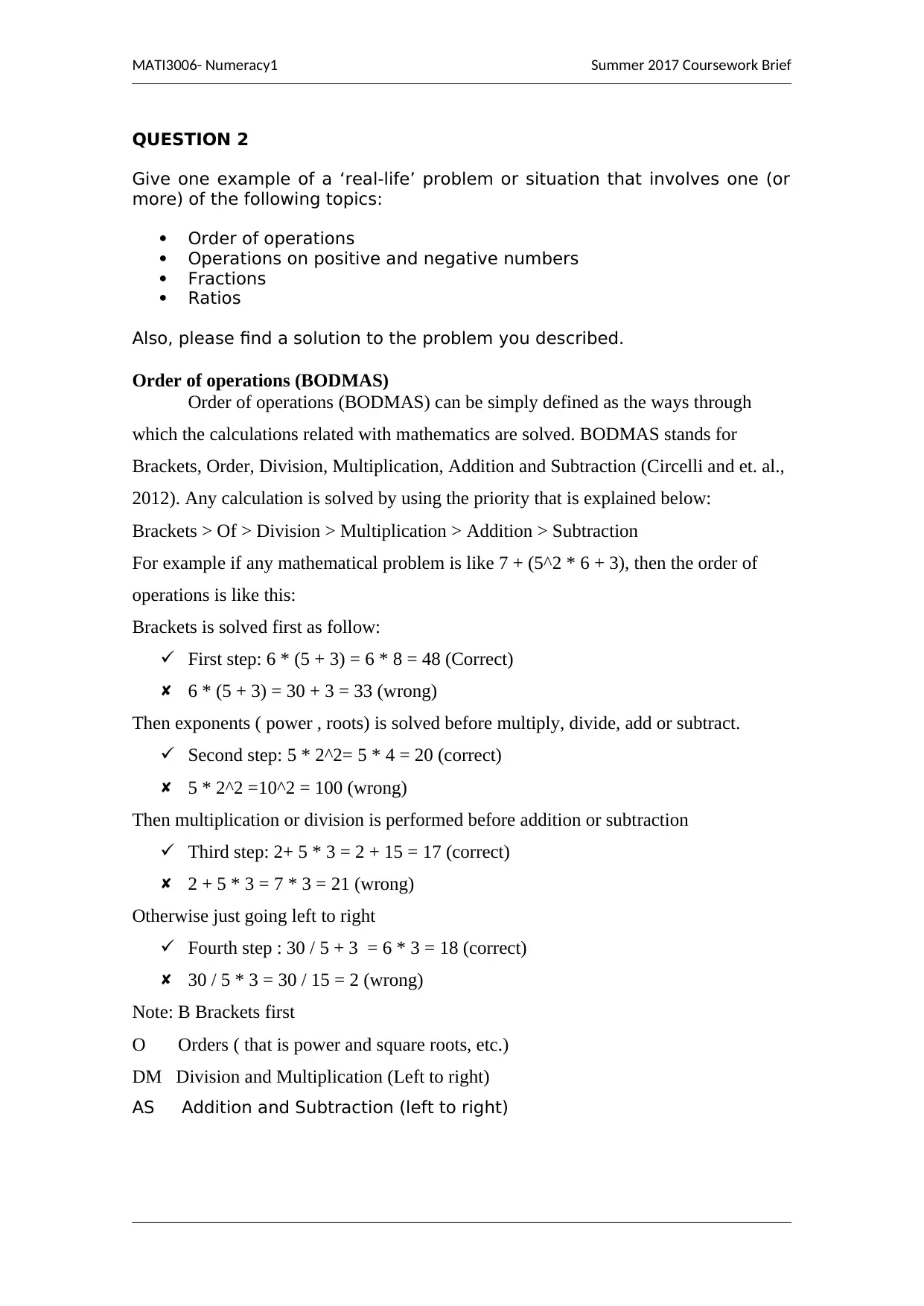
MATI3006- Numeracy1 Summer 2017 Coursework Brief
QUESTION 2
Give one example of a ‘real-life’ problem or situation that involves one (or
more) of the following topics:
Order of operations
Operations on positive and negative numbers
Fractions
Ratios
Also, please find a solution to the problem you described.
Order of operations (BODMAS)
Order of operations (BODMAS) can be simply defined as the ways through
which the calculations related with mathematics are solved. BODMAS stands for
Brackets, Order, Division, Multiplication, Addition and Subtraction (Circelli and et. al.,
2012). Any calculation is solved by using the priority that is explained below:
Brackets > Of > Division > Multiplication > Addition > Subtraction
For example if any mathematical problem is like 7 + (5^2 * 6 + 3), then the order of
operations is like this:
Brackets is solved first as follow:
First step: 6 * (5 + 3) = 6 * 8 = 48 (Correct)
6 * (5 + 3) = 30 + 3 = 33 (wrong)
Then exponents ( power , roots) is solved before multiply, divide, add or subtract.
Second step: 5 * 2^2= 5 * 4 = 20 (correct)
5 * 2^2 =10^2 = 100 (wrong)
Then multiplication or division is performed before addition or subtraction
Third step: 2+ 5 * 3 = 2 + 15 = 17 (correct)
2 + 5 * 3 = 7 * 3 = 21 (wrong)
Otherwise just going left to right
Fourth step : 30 / 5 + 3 = 6 * 3 = 18 (correct)
30 / 5 * 3 = 30 / 15 = 2 (wrong)
Note: B Brackets first
O Orders ( that is power and square roots, etc.)
DM Division and Multiplication (Left to right)
AS Addition and Subtraction (left to right)
QUESTION 2
Give one example of a ‘real-life’ problem or situation that involves one (or
more) of the following topics:
Order of operations
Operations on positive and negative numbers
Fractions
Ratios
Also, please find a solution to the problem you described.
Order of operations (BODMAS)
Order of operations (BODMAS) can be simply defined as the ways through
which the calculations related with mathematics are solved. BODMAS stands for
Brackets, Order, Division, Multiplication, Addition and Subtraction (Circelli and et. al.,
2012). Any calculation is solved by using the priority that is explained below:
Brackets > Of > Division > Multiplication > Addition > Subtraction
For example if any mathematical problem is like 7 + (5^2 * 6 + 3), then the order of
operations is like this:
Brackets is solved first as follow:
First step: 6 * (5 + 3) = 6 * 8 = 48 (Correct)
6 * (5 + 3) = 30 + 3 = 33 (wrong)
Then exponents ( power , roots) is solved before multiply, divide, add or subtract.
Second step: 5 * 2^2= 5 * 4 = 20 (correct)
5 * 2^2 =10^2 = 100 (wrong)
Then multiplication or division is performed before addition or subtraction
Third step: 2+ 5 * 3 = 2 + 15 = 17 (correct)
2 + 5 * 3 = 7 * 3 = 21 (wrong)
Otherwise just going left to right
Fourth step : 30 / 5 + 3 = 6 * 3 = 18 (correct)
30 / 5 * 3 = 30 / 15 = 2 (wrong)
Note: B Brackets first
O Orders ( that is power and square roots, etc.)
DM Division and Multiplication (Left to right)
AS Addition and Subtraction (left to right)
Paraphrase This Document
Need a fresh take? Get an instant paraphrase of this document with our AI Paraphraser
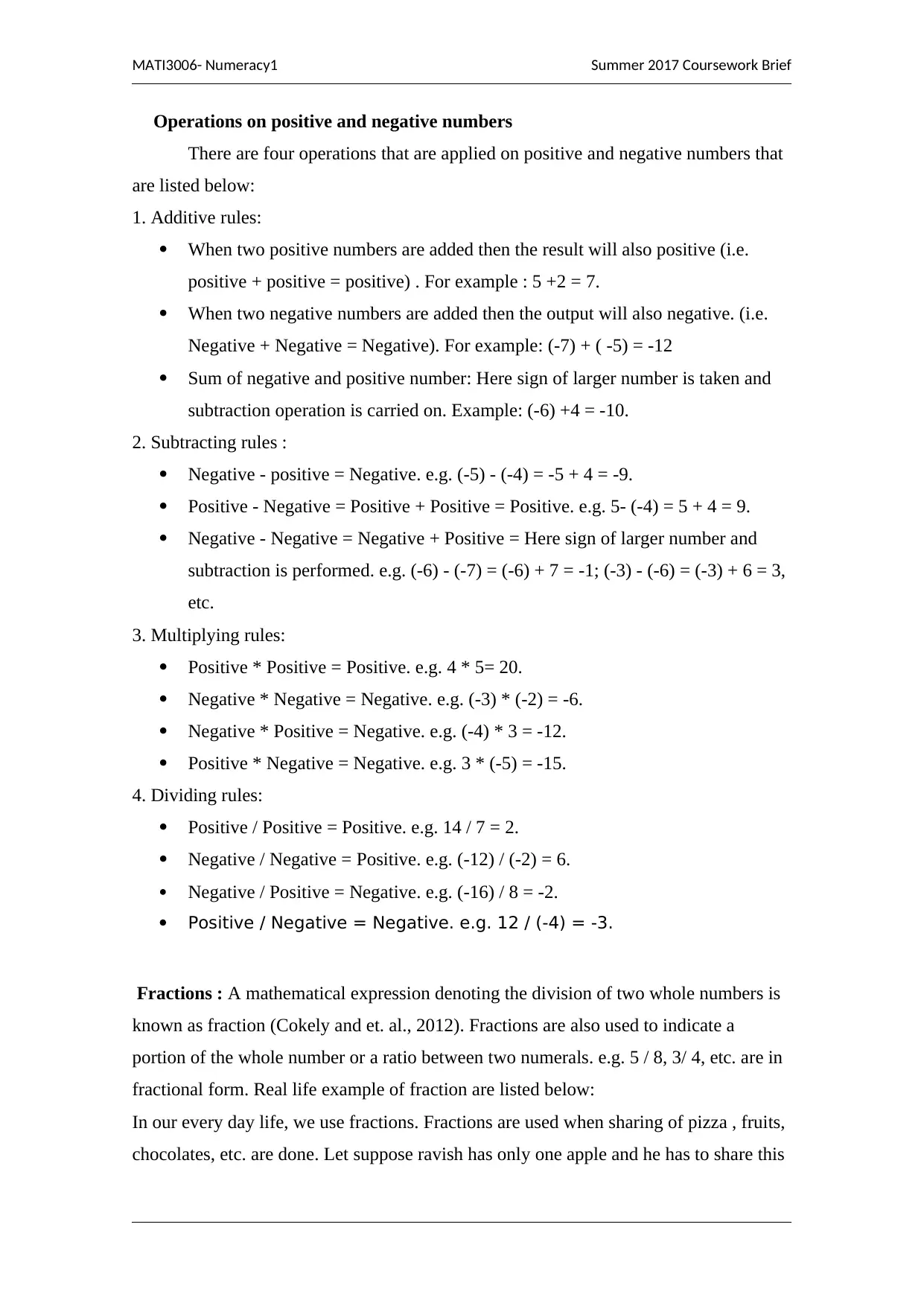
MATI3006- Numeracy1 Summer 2017 Coursework Brief
Operations on positive and negative numbers
There are four operations that are applied on positive and negative numbers that
are listed below:
1. Additive rules:
When two positive numbers are added then the result will also positive (i.e.
positive + positive = positive) . For example : 5 +2 = 7.
When two negative numbers are added then the output will also negative. (i.e.
Negative + Negative = Negative). For example: (-7) + ( -5) = -12
Sum of negative and positive number: Here sign of larger number is taken and
subtraction operation is carried on. Example: (-6) +4 = -10.
2. Subtracting rules :
Negative - positive = Negative. e.g. (-5) - (-4) = -5 + 4 = -9.
Positive - Negative = Positive + Positive = Positive. e.g. 5- (-4) = 5 + 4 = 9.
Negative - Negative = Negative + Positive = Here sign of larger number and
subtraction is performed. e.g. (-6) - (-7) = (-6) + 7 = -1; (-3) - (-6) = (-3) + 6 = 3,
etc.
3. Multiplying rules:
Positive * Positive = Positive. e.g. 4 * 5= 20.
Negative * Negative = Negative. e.g. (-3) * (-2) = -6.
Negative * Positive = Negative. e.g. (-4) * 3 = -12.
Positive * Negative = Negative. e.g. 3 * (-5) = -15.
4. Dividing rules:
Positive / Positive = Positive. e.g. 14 / 7 = 2.
Negative / Negative = Positive. e.g. (-12) / (-2) = 6.
Negative / Positive = Negative. e.g. (-16) / 8 = -2.
Positive / Negative = Negative. e.g. 12 / (-4) = -3.
Fractions : A mathematical expression denoting the division of two whole numbers is
known as fraction (Cokely and et. al., 2012). Fractions are also used to indicate a
portion of the whole number or a ratio between two numerals. e.g. 5 / 8, 3/ 4, etc. are in
fractional form. Real life example of fraction are listed below:
In our every day life, we use fractions. Fractions are used when sharing of pizza , fruits,
chocolates, etc. are done. Let suppose ravish has only one apple and he has to share this
Operations on positive and negative numbers
There are four operations that are applied on positive and negative numbers that
are listed below:
1. Additive rules:
When two positive numbers are added then the result will also positive (i.e.
positive + positive = positive) . For example : 5 +2 = 7.
When two negative numbers are added then the output will also negative. (i.e.
Negative + Negative = Negative). For example: (-7) + ( -5) = -12
Sum of negative and positive number: Here sign of larger number is taken and
subtraction operation is carried on. Example: (-6) +4 = -10.
2. Subtracting rules :
Negative - positive = Negative. e.g. (-5) - (-4) = -5 + 4 = -9.
Positive - Negative = Positive + Positive = Positive. e.g. 5- (-4) = 5 + 4 = 9.
Negative - Negative = Negative + Positive = Here sign of larger number and
subtraction is performed. e.g. (-6) - (-7) = (-6) + 7 = -1; (-3) - (-6) = (-3) + 6 = 3,
etc.
3. Multiplying rules:
Positive * Positive = Positive. e.g. 4 * 5= 20.
Negative * Negative = Negative. e.g. (-3) * (-2) = -6.
Negative * Positive = Negative. e.g. (-4) * 3 = -12.
Positive * Negative = Negative. e.g. 3 * (-5) = -15.
4. Dividing rules:
Positive / Positive = Positive. e.g. 14 / 7 = 2.
Negative / Negative = Positive. e.g. (-12) / (-2) = 6.
Negative / Positive = Negative. e.g. (-16) / 8 = -2.
Positive / Negative = Negative. e.g. 12 / (-4) = -3.
Fractions : A mathematical expression denoting the division of two whole numbers is
known as fraction (Cokely and et. al., 2012). Fractions are also used to indicate a
portion of the whole number or a ratio between two numerals. e.g. 5 / 8, 3/ 4, etc. are in
fractional form. Real life example of fraction are listed below:
In our every day life, we use fractions. Fractions are used when sharing of pizza , fruits,
chocolates, etc. are done. Let suppose ravish has only one apple and he has to share this
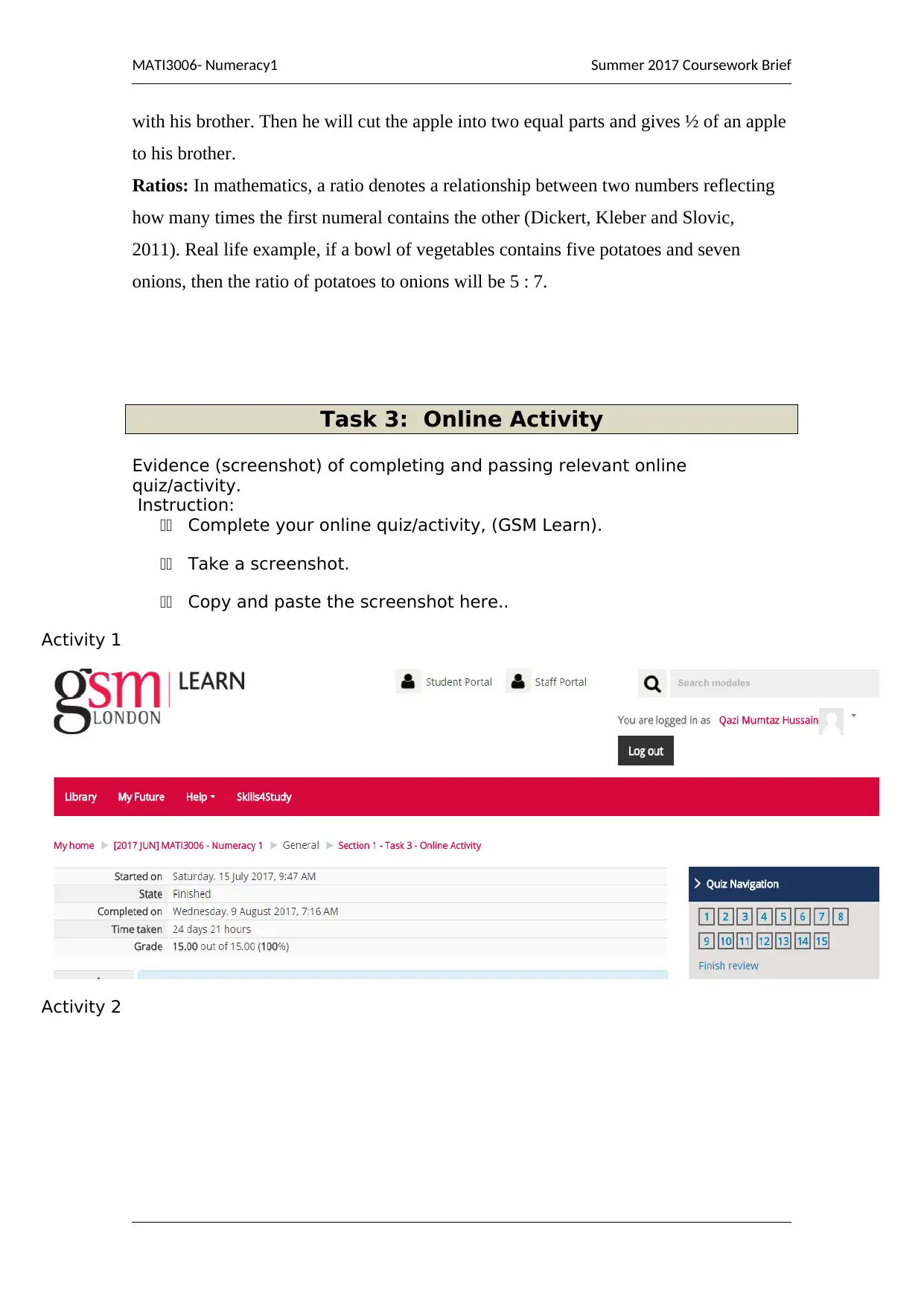
MATI3006- Numeracy1 Summer 2017 Coursework Brief
with his brother. Then he will cut the apple into two equal parts and gives ½ of an apple
to his brother.
Ratios: In mathematics, a ratio denotes a relationship between two numbers reflecting
how many times the first numeral contains the other (Dickert, Kleber and Slovic,
2011). Real life example, if a bowl of vegetables contains five potatoes and seven
onions, then the ratio of potatoes to onions will be 5 : 7.
Task 3: Online Activity
Evidence (screenshot) of completing and passing relevant online
quiz/activity.
Instruction:
11 Complete your online quiz/activity, (GSM Learn).
11 Take a screenshot.
11 Copy and paste the screenshot here..
Activity 1
Activity 2
with his brother. Then he will cut the apple into two equal parts and gives ½ of an apple
to his brother.
Ratios: In mathematics, a ratio denotes a relationship between two numbers reflecting
how many times the first numeral contains the other (Dickert, Kleber and Slovic,
2011). Real life example, if a bowl of vegetables contains five potatoes and seven
onions, then the ratio of potatoes to onions will be 5 : 7.
Task 3: Online Activity
Evidence (screenshot) of completing and passing relevant online
quiz/activity.
Instruction:
11 Complete your online quiz/activity, (GSM Learn).
11 Take a screenshot.
11 Copy and paste the screenshot here..
Activity 1
Activity 2
⊘ This is a preview!⊘
Do you want full access?
Subscribe today to unlock all pages.

Trusted by 1+ million students worldwide
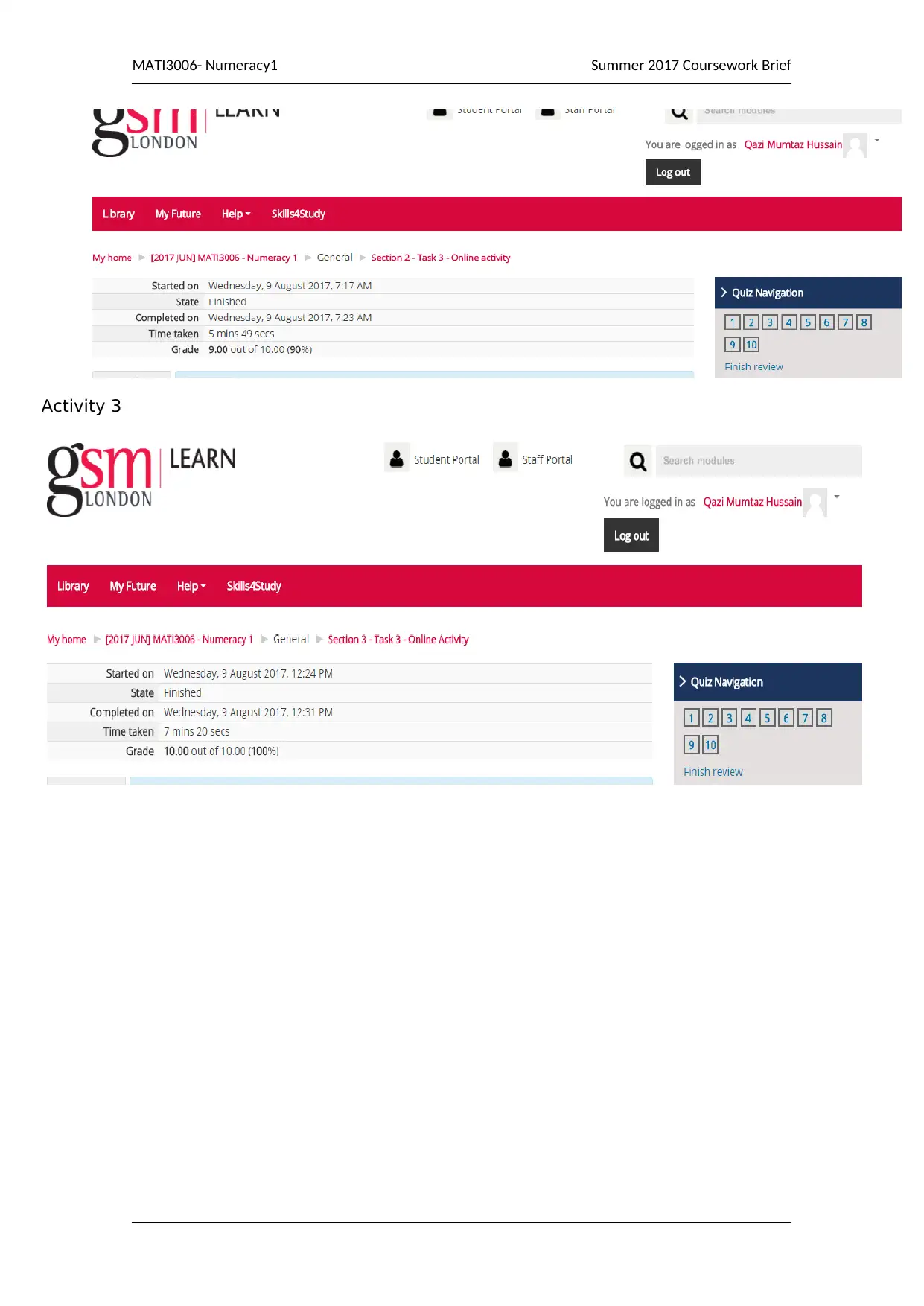
MATI3006- Numeracy1 Summer 2017 Coursework Brief
Activity 3
Activity 3
Paraphrase This Document
Need a fresh take? Get an instant paraphrase of this document with our AI Paraphraser
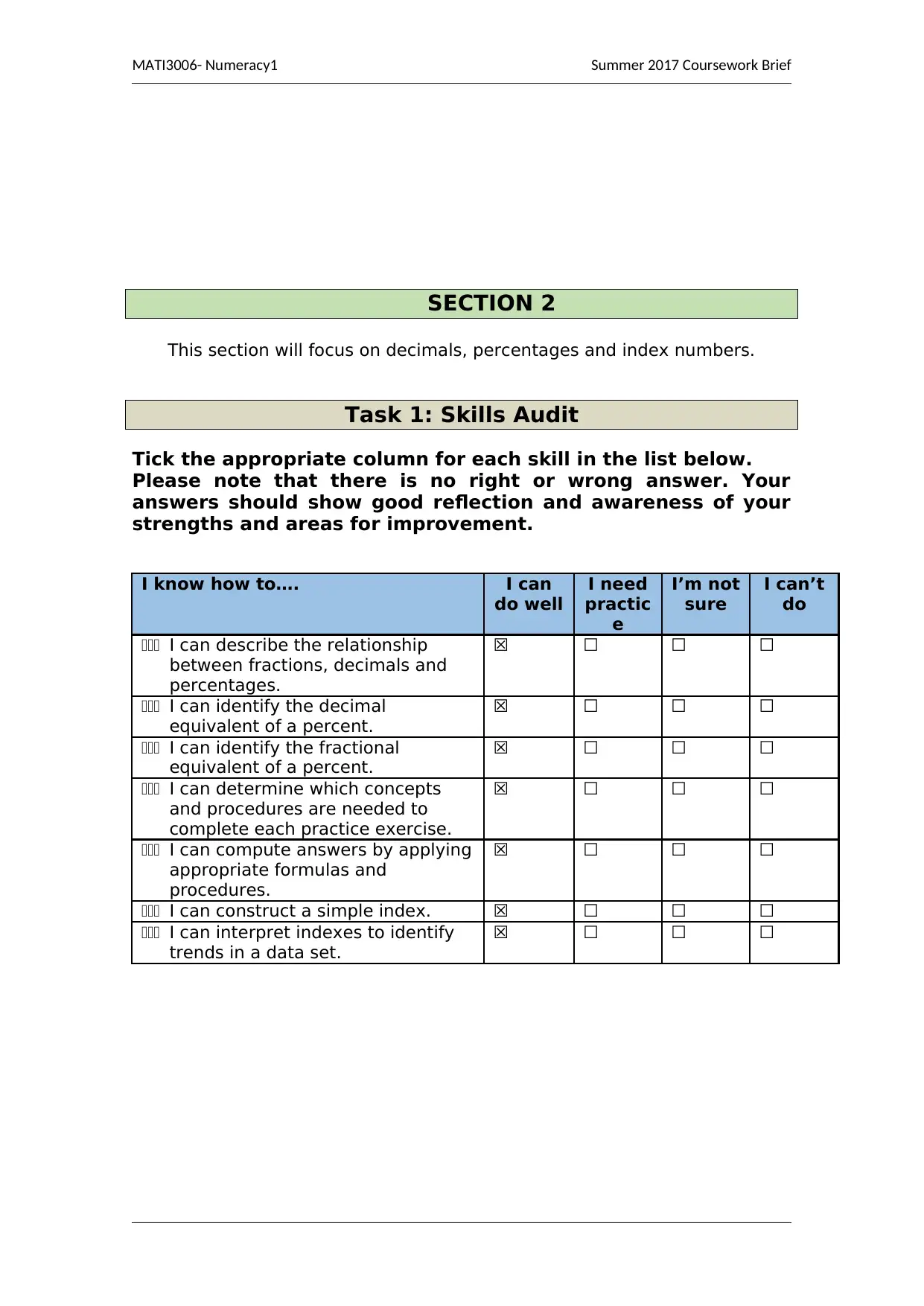
MATI3006- Numeracy1 Summer 2017 Coursework Brief
SECTION 2
This section will focus on decimals, percentages and index numbers.
Task 1: Skills Audit
Tick the appropriate column for each skill in the list below.
Please note that there is no right or wrong answer. Your
answers should show good reflection and awareness of your
strengths and areas for improvement.
I know how to…. I can
do well
I need
practic
e
I’m not
sure
I can’t
do
111 I can describe the relationship
between fractions, decimals and
percentages.
☒ ☐ ☐ ☐
111 I can identify the decimal
equivalent of a percent.
☒ ☐ ☐ ☐
111 I can identify the fractional
equivalent of a percent.
☒ ☐ ☐ ☐
111 I can determine which concepts
and procedures are needed to
complete each practice exercise.
☒ ☐ ☐ ☐
111 I can compute answers by applying
appropriate formulas and
procedures.
☒ ☐ ☐ ☐
111 I can construct a simple index. ☒ ☐ ☐ ☐
111 I can interpret indexes to identify
trends in a data set.
☒ ☐ ☐ ☐
SECTION 2
This section will focus on decimals, percentages and index numbers.
Task 1: Skills Audit
Tick the appropriate column for each skill in the list below.
Please note that there is no right or wrong answer. Your
answers should show good reflection and awareness of your
strengths and areas for improvement.
I know how to…. I can
do well
I need
practic
e
I’m not
sure
I can’t
do
111 I can describe the relationship
between fractions, decimals and
percentages.
☒ ☐ ☐ ☐
111 I can identify the decimal
equivalent of a percent.
☒ ☐ ☐ ☐
111 I can identify the fractional
equivalent of a percent.
☒ ☐ ☐ ☐
111 I can determine which concepts
and procedures are needed to
complete each practice exercise.
☒ ☐ ☐ ☐
111 I can compute answers by applying
appropriate formulas and
procedures.
☒ ☐ ☐ ☐
111 I can construct a simple index. ☒ ☐ ☐ ☐
111 I can interpret indexes to identify
trends in a data set.
☒ ☐ ☐ ☐
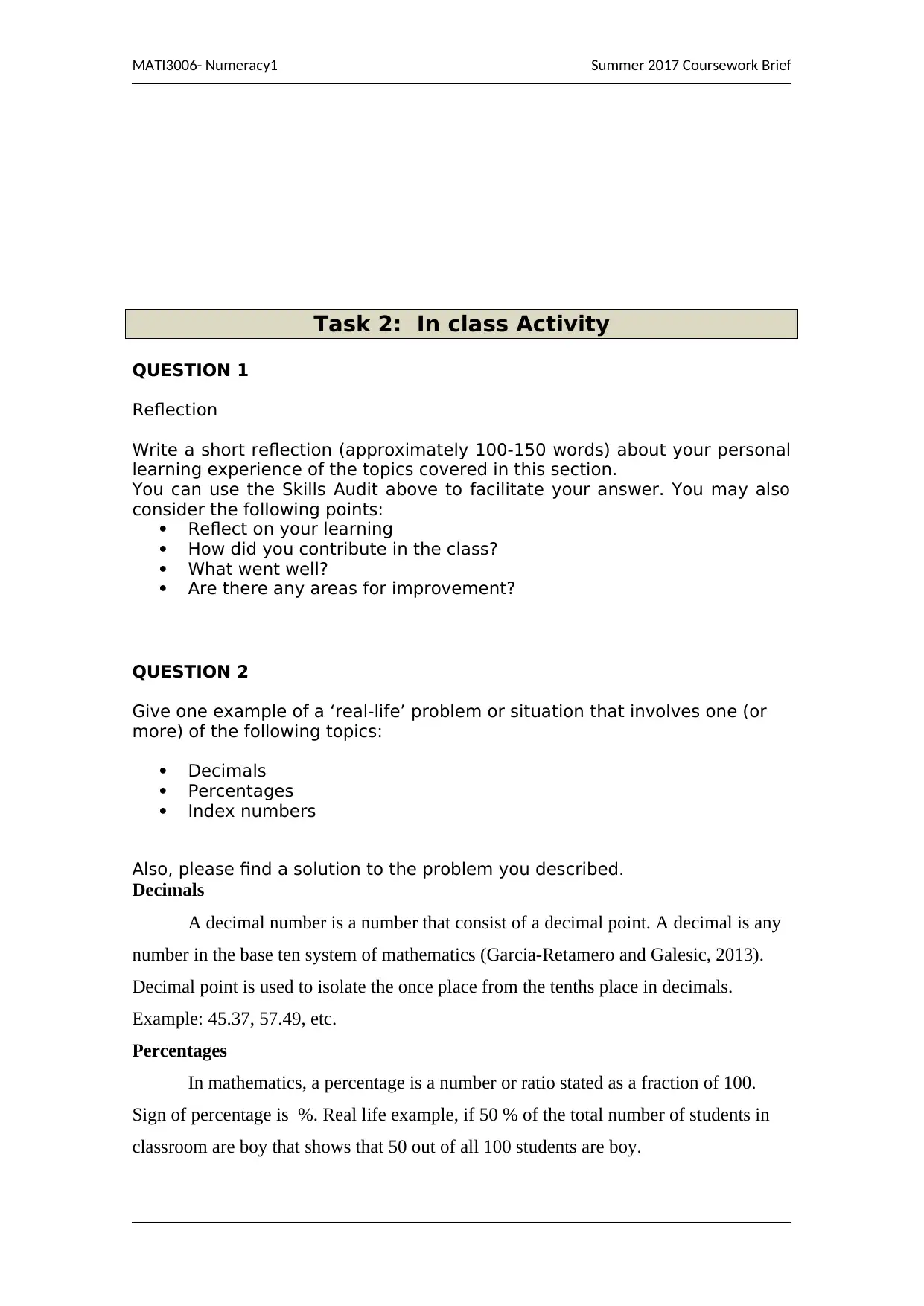
MATI3006- Numeracy1 Summer 2017 Coursework Brief
Task 2: In class Activity
QUESTION 1
Reflection
Write a short reflection (approximately 100-150 words) about your personal
learning experience of the topics covered in this section.
You can use the Skills Audit above to facilitate your answer. You may also
consider the following points:
Reflect on your learning
How did you contribute in the class?
What went well?
Are there any areas for improvement?
QUESTION 2
Give one example of a ‘real-life’ problem or situation that involves one (or
more) of the following topics:
Decimals
Percentages
Index numbers
Also, please find a solution to the problem you described.
Decimals
A decimal number is a number that consist of a decimal point. A decimal is any
number in the base ten system of mathematics (Garcia-Retamero and Galesic, 2013).
Decimal point is used to isolate the once place from the tenths place in decimals.
Example: 45.37, 57.49, etc.
Percentages
In mathematics, a percentage is a number or ratio stated as a fraction of 100.
Sign of percentage is %. Real life example, if 50 % of the total number of students in
classroom are boy that shows that 50 out of all 100 students are boy.
Task 2: In class Activity
QUESTION 1
Reflection
Write a short reflection (approximately 100-150 words) about your personal
learning experience of the topics covered in this section.
You can use the Skills Audit above to facilitate your answer. You may also
consider the following points:
Reflect on your learning
How did you contribute in the class?
What went well?
Are there any areas for improvement?
QUESTION 2
Give one example of a ‘real-life’ problem or situation that involves one (or
more) of the following topics:
Decimals
Percentages
Index numbers
Also, please find a solution to the problem you described.
Decimals
A decimal number is a number that consist of a decimal point. A decimal is any
number in the base ten system of mathematics (Garcia-Retamero and Galesic, 2013).
Decimal point is used to isolate the once place from the tenths place in decimals.
Example: 45.37, 57.49, etc.
Percentages
In mathematics, a percentage is a number or ratio stated as a fraction of 100.
Sign of percentage is %. Real life example, if 50 % of the total number of students in
classroom are boy that shows that 50 out of all 100 students are boy.
⊘ This is a preview!⊘
Do you want full access?
Subscribe today to unlock all pages.

Trusted by 1+ million students worldwide
1 out of 25
Related Documents
Your All-in-One AI-Powered Toolkit for Academic Success.
+13062052269
info@desklib.com
Available 24*7 on WhatsApp / Email
![[object Object]](/_next/static/media/star-bottom.7253800d.svg)
Unlock your academic potential
Copyright © 2020–2025 A2Z Services. All Rights Reserved. Developed and managed by ZUCOL.





